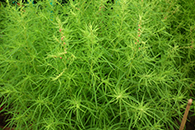Study finds invasive weed kochia's resistance to well-known herbicide stems from increase in gene copies
Thursday, Feb. 19, 2015
MANHATTAN — A recent study by a Kansas State University weed scientist finds why the invasive weed kochia is like a cockroach of the plant world.
Mithila Jugulam, assistant professor of agronomy, led a study that looked at how kochia — invasive weed populations that are taking over crops and non-crop areas in western Kansas and the Great Plains — evolved resistance to the most used herbicide glyphosate, more commonly known as Roundup Weed Killer. Researchers found that kochia has evolved to have multiple copies of a gene code that targets glyphosate. These copies enable the plants to survive the field rate of glyphosate applications.
"It's a very novel resistance mechanism and is becoming prevalent in a number of glyphosate-resistant weeds, including Palmer amaranth, common waterhemp and kochia," Jugulam said.
Jugulam conducted the study in collaboration with Kansas State University's Bikram Gill, university distinguished professor of plant pathology.
The journal Plant Physiology recently published their study, "Tandem Amplification of a Chromosomal Segment Harboring 5-Enolpyruvylshikimate-3-Phosphate Synthase Locus Confers Glyphosate Resistance in Kochia scoparia." It is the first study to find a molecular cytogenetic basis of EPSPS gene amplification in kochia.
Glyphosate works by stopping an enzyme called EPSPS that is crucial for production of aromatic amino acids in the shikimic acid pathway. If EPSPS is disrupted, the plant eventually dies.
Using an innovative technique called fluorescence in situ hybridization, or Fiber FISH, on kochia's DNA fragment, the team found that glyphosate-resistant kochia had duplicated several EPSPS copies that stacked alongside each other on a single chromosome.
Researchers also found that the more copies of EPSPS kochia had, the higher tolerance it had against glyphosate. For example, kochia plants with nine to 12 EPSPS copies could survive twice the recommended amount of glyphosate, while a plant with 16 copies could withstand six times the amount.
While the increase in EPSPS gene copies has created a nonsustainable way of controlling kochia with glyphosate-only programs, Jugulam said this resistance was evolved as the result of continuous use of glyphosate and the lack of herbicide diversity in controlling this weed.
"Herbicides are not known to cause mutations in plants," Jugulam said. "The resistant individuals present in the population initially are at low levels and slowly dominate over the susceptible plants if selection with the same herbicide continues."
Currently, Jugulam and colleagues are looking at kochia from across the U.S. and Canada to find whether plants from other areas in the world have evolved the same way. This may shed light on the future control methods.


